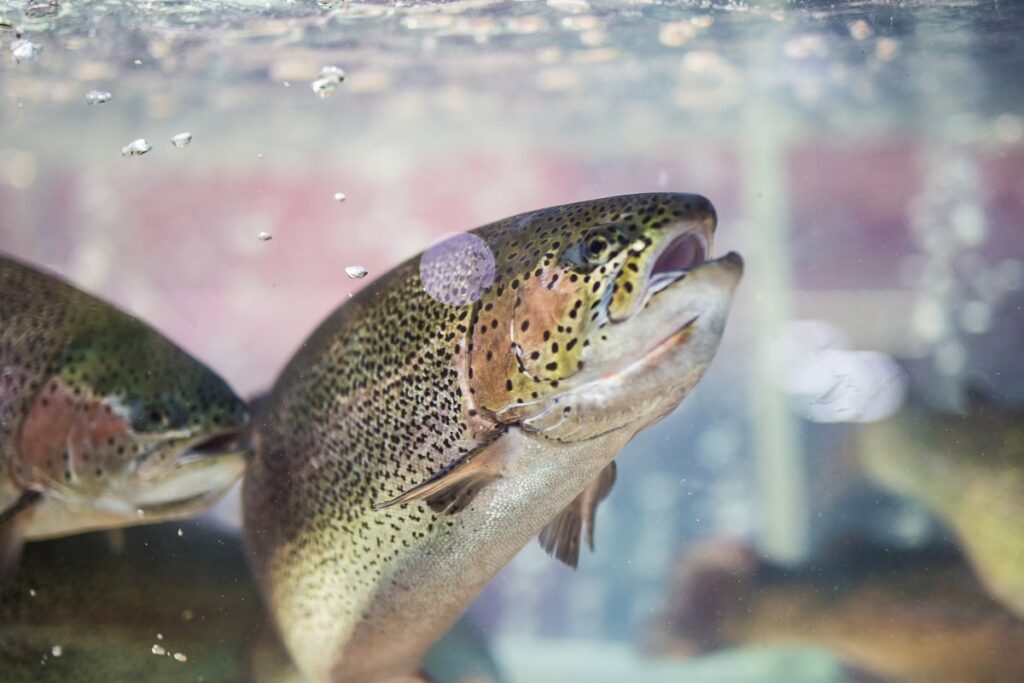Warmer Waters

Our roundup this month covers thermal stress, a mystery parasite and why your sunscreen might be bad for marine life
Climate change is making our seas warmer. This much is known, but what specific impact does temperature have on fish health?
That was the question a team of researchers at Canada’s Dalhousie University set out to answer, in relation to farmed Atlantic salmon.
Their study involved salmon at a commercial farm site in Nova Scotia. Two types of biologgers were surgically implanted in the fish to explore the effects of the thermal response of Atlantic salmon during a standard production cycle.
The aim was to measure the effective of temperature ranges on fish metabolism – specifically on “aerobic scope” which is defined as the difference between “standard metabolic rate” (the required energy to sustain base level body functions, at rest) and “maximum metabolic rate” referring to the capacity of fish to perform activity above base levels.
The temperature at which aerobic scope falls to zero is referred to as the “critical temperature” – the point at which the fish’s body starts to make trade-offs between vital functions such as activity, digestion and growth.#
In Nova Scotia, farmed fish experience seasonal extremes of temperature, both warm and cold. The biologger tags revealed that these have an effect on heart rate as well as on fish behaviour. The data suggests that the optimum temperature for the salmon was 12.7°C. Thermal stress was apparent both at high temperatures of 19°C and above, and at very low temperatures, below 2°C.
The study notes: “Physiologically, salmon can tolerate these temperature extremes, but energetic trade-offs emerge, causing changes in swimming activity, a reduction in appetite, increased metabolic rates and the synthesis of heat shock proteins.”
It concludes: “The results from this study are a good baseline for how commercial fish respond to the thermally challenging conditions prevalent in this region. Future work should consider long-term monitoring of salmon throughout the entire grow-out… biologgers offer a unique ability to monitor fish physiology and behaviour of free-swimming fish as they experience challenging environmental conditions and farm operations.”
Influence of temperature on the behaviour and physiology of Atlantic salmon (Salmo Salar) on a commercial farm (J.Korus, R.Filgueira and J.Grant) Aquaculture, August 2024.

Sunscreen ‘Nanoparticles in sunscreen may be toxic for sea life’
Nanoparticle threat
Nanoparticles are increasingly being used for a variety of applications, and particles based on zinc oxide (ZnO-NPs) are among the three most commonly produced kinds. As one of the uses of ZnO-NPs is as an effective sunscreen, as well as in environmental remediation and as a medicine, it’s not surprising that some ends up being washed into the sea. A new study suggests, however, that this could have an adverse effect on marine life.
The review of existing research was carried out jointly by academics at the University of Burdwan, West Bengal, India and the University of Messina, Italy. They investigated what is known the effect of zinc oxide nanoparticles on aquatic life.
They concluded that ZnO-NPs are more readily absorbed than are other forms of zinc oxide, by a factor between 15 and 20, and also that they had more of an impact at the cellular level.
ZnO-NPs have been shown to have a toxic effect for finfish – even though they have been used as a dietary supplement for fish feed – and even more so for aquatic invertebrates.
The researchers conclude: “These nanoparticles possess the potential to amass within fish tissues and undergo biomagnification along the aquatic trophic hierarchy. This accumulation poses a direct threat to human well-being, as consumption of such contaminated fish can lead to adverse health effects attributable to ZnO-NPs.

Atlantic salmon
“Exposure to ZnO-NP has negative effects on aquatic invertebrates. All of the evidence points to the fact that ZnO-NPs negatively impact the complicated web of interactions and the delicate balance of the aquatic food chain in these habitats.”
Exploring the impact of zinc oxide nanoparticles on fish and fish-food organisms: A review (Ahamadul Hoque Mandal, Surajit Ghosh, Ditipriya Adhurjya, Priyajit Chatterjee, Ishita Samajdar, Giuseppe Piccione, Dip Mukherjee, Kishore Dhara, Nimai Chandra Saha, Cristiana Roberta Multisanti, Shubhajit Saha and Caterina Faggio) Aquaculture Reports, June 2024.
Mystery parasite
Around 160,000 rainbow trout in three publicly-owned hatcheries in the US state of Oregon had to be slaughtered, after they were found to have been infected by a parasite not previously believed to be a problem in the region.
Researchers from Oregon State University and the Oregon Department of Fish and Wildlife have been trying to identify the microscopic parasite. It is a new problem for Oregon but in neighbouring Montana a similar parasite led to the deaths of tens of thousands of salmon in 2016. Scientists believe it is a kind of myxozoan but so far have not been able to say specifically which, of around 2,400 species, it might be.
“We’re hoping we can find out more about it because with the change in climate, warmer rivers — those conditions favour pathogens. It may be that we see this or something else again,” Michelle Dennehy, spokesperson with the Oregon Department of Fish and Wildlife, told local broadcaster Jefferson Public Radio.


